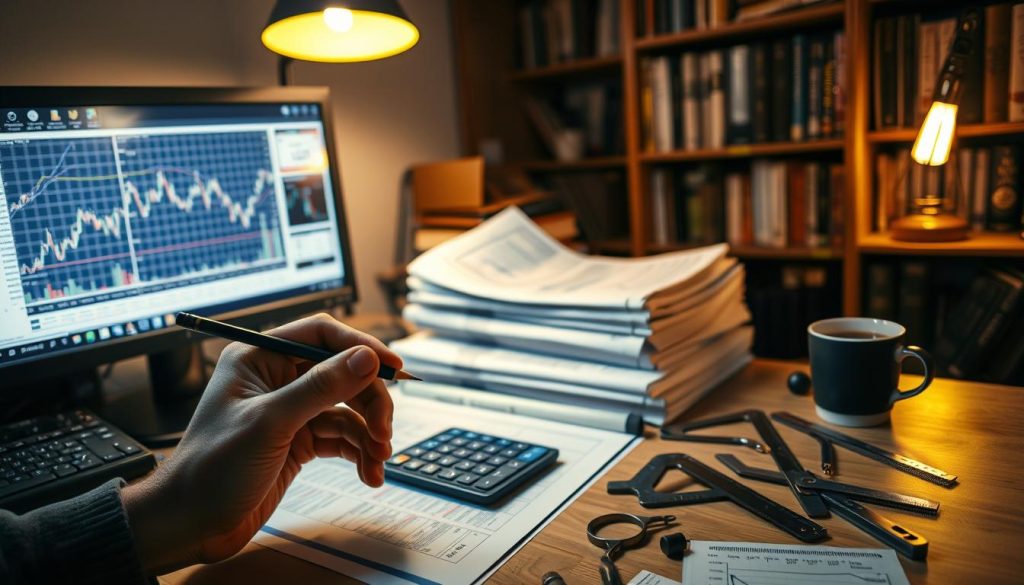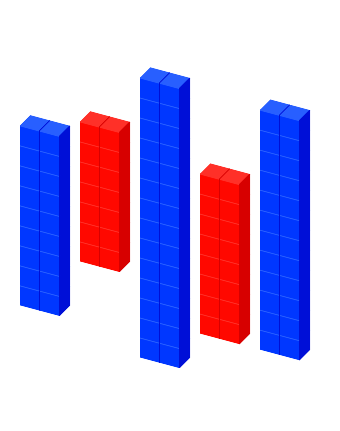How to Avoid Common Mistakes That Lead to Prop Firm Evaluation Failures

Prop firm evaluations need careful planning and strict trading rules. Traders often face big challenges during these tests. One wrong move can stop their chance to succeed in trading.
To pass prop firm evaluations, it’s not just about knowing the market. Traders must also handle risks well, stay calm under pressure, and follow a solid trading plan. This shows they understand the market and can act with discipline.
Knowing what prop firms look for is key. Traders who get good at technical analysis, managing their emotions, and planning ahead have a better shot at making it through tough trading tests.
Key Takeaways
- Master comprehensive risk management techniques
- Develop consistent trading strategies
- Control emotional responses during evaluations
- Understand detailed prop firm metrics
- Practice disciplined trading execution
Understanding Prop Firm Evaluation Fundamentals
Getting into proprietary trading firms needs a deep grasp of key concepts. Traders aiming to excel in prop firm evaluations must learn advanced skills and strategies. These go beyond basic trading methods.
Prop firm evaluations are tough tests to find skilled traders. They look for those who can make profits and handle risks well. These tests check if traders can use complex trading metrics and meet certain performance standards.
Key Components of Trading Evaluations
Trading evaluations cover a few key areas:
- Profit target achievement
- Risk management capabilities
- Consistent trading performance
- Psychological discipline
Standard Evaluation Metrics and Requirements
Traders need to know the specific standards prop firms use. These standards often include:
- Minimum profit targets
- Maximum acceptable drawdown levels
- Trading consistency
- Risk-to-reward ratio management
“Success in prop firm evaluations comes from understanding and mastering the underlying trading metrics, not just executing trades.”
Time-frame Considerations for Success
The evaluation period is set, and traders must show their skills within it. Traders need to develop strategies that can consistently perform within these predefined time constraints.
Prop firms use these basics to find traders who can make steady profits and manage risks well. Knowing these standards is key for anyone wanting to do well in prop trading assessments.
Common Trading Psychology Pitfalls in Evaluations
Trading psychology is key in prop firm evaluations. Emotional trading can turn skilled traders into unexpected failures. Mental preparation is vital for overcoming psychological hurdles in high-stakes trading.
“Your mind is your most powerful trading tool – master it, and you master the market.”
Traders often face psychological barriers that hurt their performance. These mental hurdles show up in several ways:
- Fear-driven decision paralysis
- Impulsive trading due to emotional reactions
- Overconfidence leading to too much risk
- Performance anxiety during evaluations
Understanding trading psychology means knowing emotional triggers. Traders need strong mental preparation to stay calm and focused. Mindfulness, breathing exercises, and meditation before trading can help manage emotions.
Managing emotional trading involves several strategies:
- Setting clear trading rules
- Having risk management plans
- Practicing self-reflection
- Keeping a disciplined trading journal
Successful traders in prop firm evaluations know emotional intelligence is as important as technical skills. A strong mental framework helps turn psychological challenges into growth opportunities and consistent performance.
Essential Risk Management Strategies for Evaluation Success
When it comes to prop firm evaluations, managing risk is key. Traders know that keeping their capital safe is as important as making profits. Using smart risk management can really boost your chances of doing well in tough trading tests.

Top traders see risk management as the heart of lasting success in trading. Here are some ways to stay disciplined and in control during prop firm evaluations:
Position Sizing Guidelines
Position sizing is a big part of managing risk. It decides how many shares or contracts you trade. The main rules are:
- Never risk more than 1-2% of your total account balance on a single trade
- Calculate position size based on your predetermined risk tolerance
- Use precise mathematical formulas to determine optimal trade volumes
Stop Loss Implementation
Stop loss strategies are vital for keeping your trading capital safe. Here’s how to do it right:
- Set clear stop loss levels before entering a trade
- Use technical indicators to find the right stop placement
- Keep the same stop loss distance for all trades
“Preservation of capital is the first rule of investing.” – Warren Buffett
Maximum Drawdown Management
Managing maximum drawdown means controlling risk and planning ahead. Here are some tips:
- Set a strict maximum drawdown limit (usually 5-10% of account balance)
- Have automatic trading pauses when drawdown limits are near
- Have a plan for recovering from losses
By using these risk management strategies, traders can improve their performance in prop firm evaluations. They show they are true professionals in trading.
Trading Plan Development and Execution
Creating a solid trading plan is key to success in prop firm evaluations. A good strategy turns random trading into a structured and disciplined process. Traders need a detailed plan that guides every decision with precision and clarity.
“A trading plan is your roadmap to consistent performance and financial success.” – Professional Trader
What makes a trading plan effective includes:
- Clear entry and exit rules
- Predefined risk management parameters
- Specific performance benchmarks
- Detailed market analysis techniques
Consistency in execution is crucial for any trading strategy. Traders must stick to their plan, no matter what the market does or how they feel.
To keep strategy development strong, try these:
- Document every trade carefully
- Check performance every week
- Change strategy based on data
- Stay emotionally neutral
The main difference between successful and struggling traders is their ability to create and stick to a solid trading plan. Prop firm evaluations look for a strategic approach that combines technical skill, discipline, and careful execution.
How to Avoid Common Mistakes That Lead to Prop Firm Evaluation Failures
Prop firm evaluations are tough. They test traders’ skills, discipline, and mental strength. To pass, avoiding big mistakes is crucial.

Getting through prop firm evaluations needs a smart plan. This plan must cover all aspects of trading.
Overtrading Prevention Strategies
Overtrading is a big risk during evaluations. To avoid it, try these methods:
- Set strict daily trade limits
- Establish clear entry and exit criteria
- Recognize market conditions unsuitable for trading
- Use trading software to track and restrict trade frequency
Emotional Control Techniques
“The key to successful trading is not predicting the market, but controlling your emotional response to market movements.” – Professional Trader
Keeping emotions in check is key in prop firm evaluations. Improve your mental strength with:
- Mindfulness meditation practices
- Pre-trade psychological checklists
- Stress management techniques
- Consistent self-reflection
Trade Documentation and Analysis Methods
Good trade documentation helps traders see their strengths and weaknesses. It includes:
- Detailed trade journals
- Performance metric tracking
- Regular self-assessment reviews
- Systematic error analysis
By using these strategies, traders can boost their chances of success. They can reduce overtrading risks and stay emotionally disciplined.
Market Analysis Techniques for Consistent Performance
Successful traders know that deep market analysis is key to consistent trading. They master both technical and fundamental analysis. This gives them a strong base for making smart choices during prop firm checks.

- Technical Analysis: Studying price patterns and chart indicators
- Fundamental Analysis: Examining economic factors and market conditions
“Knowledge of market dynamics separates successful traders from average performers.” – Professional Trading Mentor
Good market analysis needs a wide strategy. Traders should get good at:
- Reading multiple timeframe charts
- Following economic indicators
- Understanding market mood
| Analysis Type | Key Focus Areas | Primary Tools |
|---|---|---|
| Technical Analysis | Price movement patterns | Moving averages, RSI, MACD |
| Fundamental Analysis | Economic events | News releases, GDP reports |
Mixing technical and fundamental analysis is a solid way to evaluate markets. Traders who get better at analysis boost their chances of doing well in prop firm reviews.
Pro tip: Keep practicing market analysis to get better at making trading decisions.
Managing Trading Hours and Time Zones Effectively
Successful prop firm traders know that time management is key. They plan their trading schedule carefully. They understand market sessions in different time zones.

Traders need a solid plan to manage their trading hours. This helps them make the most of opportunities and meet evaluation needs. The global markets have connected sessions, each with its own chances and challenges.
Optimal Trading Schedule Creation
Creating a good trading schedule involves several important steps:
- Find the most volatile market times
- Match trading times with when you’re most alert
- Think about your personal time zone
- Choose market sessions that fit your trading style
Market Session Selection Strategy
Each market session has its own traits that can affect trading results. Knowing these differences is key for success in prop firm evaluations.Avoid scams in the prop firm industry
| Market Session | Peak Hours | Volatility Level |
|---|---|---|
| Asian Session | 11 PM – 8 AM EST | Low to Moderate |
| European Session | 3 AM – 12 PM EST | High |
| North American Session | 8 AM – 5 PM EST | Very High |
“Successful trading is about precision, timing, and understanding market rhythms.” – Professional Trader
Traders should use time management to stay focused and avoid getting tired. Picking the right market sessions can greatly boost their trading success and prop firm evaluation scores.
Technical Analysis Tools and Their Proper Application
Mastering technical analysis is key for traders aiming to succeed in prop firm evaluations. Tools like technical indicators, chart patterns, and price action offer deep insights into market trends. Traders need to develop a detailed approach to use these tools well.

- Moving averages
- Relative strength index (RSI)
- Bollinger Bands
- Support and resistance levels
- Candlestick pattern recognition
“Understanding technical indicators is not about blind following, but intelligent interpretation.” – Professional Trading Mentor
Successful traders know that no single technical indicator shows the whole market picture. Price action analysis needs a complete view, using many tools together to check trading signals.
| Technical Tool | Primary Function | Best Use Case |
|---|---|---|
| Moving Averages | Trend Identification | Long-term trend confirmation |
| RSI | Momentum Measurement | Identifying overbought/oversold conditions |
| Bollinger Bands | Volatility Tracking | Market range and potential breakouts |
Prop firm evaluators look for traders with advanced technical analysis skills. Using various chart patterns and technical indicators builds a strong trading plan. This plan reduces risk and boosts potential gains.
Understanding Leverage and Position Management
Trading well in prop firms means knowing about leverage and managing positions. Traders must find ways to make more money while keeping risks low.

Good position management starts with controlling risk well. Traders must make smart choices to meet prop firm standards.
Calculating Appropriate Position Sizes
Getting the right position size is key for steady results. Traders should think about:
- Account balance
- Risk tolerance
- Leverage available
- Market volatility
“The key to successful trading is not just entering trades, but managing them with precision.” – Professional Trader
Risk-Reward Ratio Optimization
Improving the risk-reward ratio needs careful planning and discipline. Traders should aim for a balance that offers good gains with safe risks.
| Risk Parameter | Recommended Range | Impact on Performance |
|---|---|---|
| Risk per Trade | 1-2% | Preserves capital |
| Risk-Reward Ratio | 1:2 or 1:3 | Maximizes potential returns |
| Leverage Usage | 2:1 to 5:1 | Manages potential losses |
Leverage is very important in managing positions. Smart traders know leverage can be both a blessing and a curse – it boosts gains but also increases losses.
Effective position management includes:
- Set clear risk limits
- Use stop-loss orders all the time
- Keep an eye on market changes
- Change position sizes with market shifts
Building a Sustainable Trading Strategy
Creating a strong trading strategy is key to doing well in prop firm evaluations. A good strategy is more than just when to buy and sell. It needs careful planning, thorough backtesting, and smart adjustments to handle different market situations.

- Comprehensive market analysis
- Consistent risk management
- Adaptive approach to market changes
- Precise strategy optimization techniques
“A well-tested trading strategy is your roadmap to consistent performance.” – Professional Trader
Backtesting is vital in making a strategy. Traders must test their strategy in many market scenarios. This helps spot its strong and weak points before using real money.
| Strategy Component | Evaluation Criteria | Optimization Potential |
|---|---|---|
| Entry Signals | Accuracy Rate | High |
| Risk Management | Drawdown Protection | Critical |
| Position Sizing | Capital Preservation | Medium |
Optimizing a strategy is a fine art. Traders must avoid over-optimizing, which can make the strategy unreliable. The aim is to have a flexible trading strategy that changes with the market while keeping risk management at its core.
Top prop firm traders know that a good strategy keeps evolving. They keep learning, regularly check their strategy, and are open to making changes. This is how they achieve long-term success in trading.
Record Keeping and Performance Tracking Methods
Successful traders know that a good trading journal is key. It’s not just about keeping records. It’s about understanding your trading habits and getting better at it.
Keeping a detailed trading journal takes discipline and focus. Traders need to write down every trade decision to learn from it.
Essential Elements of a Trading Journal
- Trade entry and exit points
- Specific market conditions
- Emotional state during trading
- Rationale behind each trade
- Psychological barriers encountered
Performance Metrics Analysis
Good trade analysis means tracking important performance signs. These signs show your trading strengths and weaknesses. Key metrics include:
- Win rate percentage
- Average profit per trade
- Risk-to-reward ratio
- Maximum drawdown
- Total trading capital growth
“What gets measured gets managed” – Peter Drucker
Digital tools make tracking easier. They help traders create detailed reports and see their progress. By regularly checking these metrics, traders can make smart choices and improve their strategies.
Continuous Improvement Strategy
A good trading journal turns data into useful lessons. Traders who track their performance well can improve their skills and manage risks better.
Implementing Recovery Strategies After Losses
Dealing with losses during prop firm evaluations can be tough for traders. To bounce back, you need a smart plan. This plan should mix good trading psychology with careful risk management.
Traders who do well know losses are part of the game. The secret to making it through is having strong recovery plans. These plans keep your money and mind safe.
- Emotional Reset: Take a break after big losses to avoid acting on impulse
- Analytical Review: Look closely at why your trades didn’t work out
- Risk Management Reassessment: Change how you size your positions and set stop-losses
“The true measure of a trader is not avoiding losses, but how they recover from them.” – Professional Trading Mentor
Creating a solid loss recovery plan involves a few key steps:
- Do a deep dive into your trades
- Find out where your trading skills are weak
- Slow down your trading for a bit
- Build back your confidence with smaller, more controlled trades
During loss recovery, managing risk is crucial. Traders must stay disciplined and avoid making emotional trades. A careful approach helps keep your money and mental health safe during tough times.
The best traders see losses as chances to learn. By always looking to improve and learning from mistakes, you can turn setbacks into valuable lessons. These lessons can make you a stronger trader in the long run.
Conclusion
To succeed in prop firm trading, you need more than just good trading skills. You must also have strong evaluation strategies. These include staying disciplined, managing risks, and always looking to improve.
Every challenge in prop firm trading is a chance to learn and grow. It’s important to stay strong and keep learning from each experience. This way, you can overcome any obstacle.
Just being good at trading isn’t enough. You also need to understand the market well, size your positions correctly, and control your emotions. These skills help you succeed in prop firm evaluations.
Knowing how the market works and having a solid trading plan are key. Keeping track of your performance is also crucial. These steps help you stand out from others.
Improving continuously is essential for long-term success in trading. Each evaluation is a chance to get better, learn from your mistakes, and adjust your strategies. This mindset helps you grow and succeed in the competitive world of prop firm trading.
Your trading journey is a path of personal growth and strategy improvement. By staying disciplined, controlling your emotions, and always analyzing your performance, you can turn prop firm evaluations into stepping stones to success.
FAQ
What are the most common mistakes traders make during prop firm evaluations?
Traders often overtrade and fail to manage risk well. They also don’t stick to a trading plan and make emotional decisions. Not documenting trades is another mistake. Fear and greed can lead to impulsive trading.
How important is risk management in prop firm evaluations?
Risk management is key. Traders should risk 1-2% of their account per trade. They should use stop-loss strategies and size positions wisely. This shows they can protect capital.
How can I develop a consistent trading strategy for prop firm evaluations?
Start by backtesting your strategy. Create clear rules for entering and exiting trades. Define your risk and stay disciplined. Aim for a strategy that works in all markets.
What psychological challenges do traders face during prop firm evaluations?
Traders face many challenges, like fear and overconfidence. They might trade impulsively or abandon plans under stress. These challenges can lead to poor decisions.
How do I manage drawdown limits during a prop firm evaluation?
Manage drawdowns by controlling risk and staying disciplined. Set daily loss limits and use stop-loss orders. Avoid aggressive trading after losses. Stay calm and follow your plan.
What documentation is crucial for prop firm evaluation success?
Keep a detailed trading journal. It should track every trade, including reasons and outcomes. Record win rates and analyze performance regularly. This helps identify areas for improvement.
How can I optimize my trading schedule for prop firm evaluations?
Choose the best market sessions for your strategy. Trade consistently and align with market liquidity. Consider your peak performance times and market characteristics.
What technical analysis tools are most effective for prop firm evaluations?
Use multiple indicators and analyze price action. Identify trends and volume indicators. Avoid relying on one indicator. A comprehensive approach is best.
How do I recover from losses during a prop firm evaluation?
Stay disciplined and follow your plan. Avoid revenge trading and use a reduced-risk approach. Analyze mistakes and adjust your strategy. Keep managing risk well.
What leverage strategies work best in prop firm evaluations?
Use careful position sizing and maintain a risk-reward ratio. Avoid overleveraged trades. Risk no more than 1-2% per trade. Use leverage wisely to protect capital.
